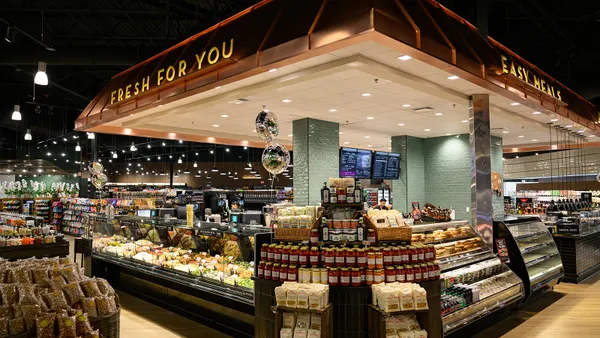Dive Brief:
- Investments food retailers and wholesalers made in 2019, like enhancing e-commerce and embracing technology, coupled with a strong operational performance, allowed the industry to remain flexible when facing challenges posed by the coronavirus pandemic, according to a newly released survey from the Food Industry Association (FMI).
- Online sales grew from 1.4% of total sales in 2018 to 2.5% last year, with 67% of retailer respondents saying they experimented with e-commerce last year. Meanwhile, 75% said they turned to technology to improve efficiencies.
- Problems plaguing retailers last year, like supply chain challenges, rising employee costs and high interchange fees for credit and debit cards, are expected to continue through the rest of 2020, FMI experts said during a webinar last week.
Dive Insight:
“By most measurements, 2019 was a good year for the food retail industry,” FMI President and CEO Leslie Sarasin said Wednesday during a webinar about the new survey.
Last year, same-store sales rose 3.3%, and employee turnover decreased from 45% in 2018 to 40%, according to the survey. A majority of retailers expanded their online fulfillment capacities and e-commerce presence.
FMI sent the survey in June to U.S. and Canadian retailers and wholesalers, asking them to reflect on the changes and challenges of 2019 and the first few months of the coronavirus pandemic and to make projections for the future of the industry.
Significant challenges retailers faced last year haven’t gone away and, in some cases, have become magnified during the pandemic, according to FMI experts who weighed in on the findings during the webinar. Competition from online retailers selling food was listed as one of the biggest factors negatively impacting business in 2019, according to 75% of the respondents.
“This pre-COVID-19 tip of the hat to online competition was a solid acknowledgment that e-commerce as a rival is a force to be reckoned with, but at that point, no one knew the speed at which that reckoning was really arriving,” Mark Baum, senior vice president of industry relations and chief collaboration officer at FMI, said. Key questions facing food retailers now are if, where and when online usage will level out, he added.
Challenges from the coronavirus pandemic aside, Jennifer Hatcher, who oversees regulatory impacts on the supermarket industry at FMI, said that interchange fees are one of the biggest threats to profitability, with 81% of respondents saying the fees negatively impacted their business.
The survey found that the fees averaged 1% of total sales in 2019 — a significant amount for an industry known for thin profit margins, Hatcher said. With mobile payments on the rise — 87% of stores now accept them, the survey found — the transaction fees appear to be a growing concern.
Other costs respondents identified as challenges last year include healthcare benefits (73%), wages (69%) and international trade and tariffs (52%). Facing a competitive job market, 93% of retailers last year offered higher compensation either through wages or bonuses, the survey said. Food retailers spent, on average, $314 per employee on training and skills development last year, and a majority of survey respondents said they expect those costs will increase in 2020, Hatcher said.
How respondents felt about their collaborations with suppliers and manufacturers saw a shift, with favorable perceptions dropping from 45% in 2019 to 35% during the pandemic and negative ones rising from 10% to 38%. Meanwhile, food retailers’ perceptions of trucking and transportation capacity remained about the same, with around half saying there were negative impacts.
Despite the challenges, the FMI experts said that the food retail industry can continue to build upon the trends and services that gained traction last year.
A majority of the respondents said that consumer health and wellbeing offerings (75%), new ways to communicate with consumers (72%) and leveraging food to combat health issues (71%) had positive impacts in 2019. Viewing consumers’ changing meal consumption as a positive influence on the food retail business jumped nearly 20 percentage points, from 56% in 2019 to 75% in 2020.
“Now more than ever, the food industry is positioned to build on the trust and partnership of being on the shoppers’ side, helping them achieve their dietary goals of eating well to stay as healthy as possible,” Dr. Hilary Thesmar, who oversees food safety and quality programs at FMI, said.
Sarasin said food retailers can also focus on family meals, which she said have been a key factor keeping families healthy during the pandemic, by providing meal ideas and resources to consumers.











